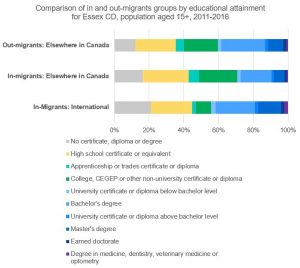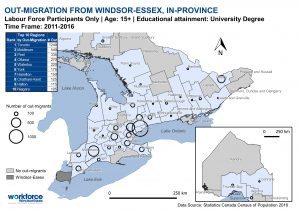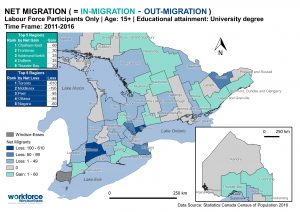Brain Drain or Brain Gain? The Migration of our Workforce by Education Level
Workforce Migration Series: Article 3
October 2, 2019
The Workforce Migration Series follows Julian’s analysis as he distills data on the migration of the workforce to and from Windsor-Essex. You can check out the earlier articles on our Labour Market Insights page. This research is part of our #STARTyqg project, which aims to develop workable recommendations for better attracting and retaining talent at the employer and regional levels in Windsor-Essex.
Today’s economy, globally and in Windsor-Essex, relies more on a well-trained and educated workforce than it ever has. Forces like automation and globalization not only cause low-skilled jobs to be replaced by machines and moved overseas: these are also forces that Canadian companies are actively leveraging to grow. And to grow successfully in these environments increasingly driven by technology and innovation there is a need for skilled people, particularly university-educated workers and workers with skilled trades credentials. This trend certainly applies in Windsor, where we boast an automation cluster of over 350 companies, and where our in-demand jobs are increasingly those requiring vocational training or post-secondary education.
Meeting this demand locally is imperative if we are to sustain and improve the quality of living in Windsor-Essex. Ensuring that we are retaining these skilled individuals, and attracting more from other regions, is key to succeeding in this globally competitive environment.
In the first article in this series, we saw that Windsor was relatively strong in attracting workers with skilled trades and college credentials, but weaker in attracting and retaining university-educated workers between 2011 and 2016. For every 2 workers who moved to Windsor-Essex from another part of Canada with a university education, 3 left.
So how can we improve our regional capacity to attract and retain university-educated workers, and how can we build our success in attracting workers with skilled trades credentials?
Using data on the origin and destination of workers by educational attainment, we’ll begin to answer the above question by breaking down how individuals moved into and out of Windsor-Essex based on their education level. Our primary findings are the following:
- International migration is an important source of university-educated people for Windsor-Essex. Expanding this and focusing on retaining newcomers to Canada in our region who were educated locally or internationally will support the growth of our university-educated talent pool.
- Attraction strategies for skilled trades workers should focus on similarly-sized regions in Ontario
- Larger urban areas are both the major origin and destination of university-educated workers moving into and out of Windsor-Essex. Replicating the conditions that attract workers to these regions may be one key to our long-term success.
The bigger picture: international vs. domestic movement
We’ll start by taking a look at how educational levels varied across three categories of movers:
- Individuals who moved out of the region between 2011 and 2016 and to another part of Canada;
- Individuals who moved to the region in this time frame between 2011 and 2016 from another part of Canada, and;
- Individuals who moved to the region in this time frame from another country.

The above chart compares the percent share of each level of educational attainment for each of these three groups. Comparing the first two shows us something we may have already figured based on the first article of this series: the proportion of university educated people (all categories in a shade of blue) is larger in the “Elsewhere in Canada” out-migrant group than the in-migrant group. In other words, the people who left our region were more highly educated than those who moved here from somewhere else in the country.
Alone, these two bars would suggest a serious case of brain drain. However, bringing international migration into the picture changes this: looking at the bottom bar, we see that the proportion of university-educated people among those who moved to the region from another country is very high, and in fact the highest among the three groups. The data, as shown in the above graph, suggests that international migration is an important area for strategizing to offset reductions of our university-educated talent pool, and indeed to grow it.
While the significance of international migration may change (and perhaps already has since 2016), for now it may still be secondary to the scale of migration between Windsor-Essex and other regions in Ontario. When looking at just active workers in Windsor-Essex who moved to the region between 2011 and 2016, the number of those coming from another region of Ontario (8460) was almost double the number of those coming from another country (4715). We’ll now turn our attention to where those in-province movers to Windsor-Essex came from, and where their counterparts moved to.
in-province destinations and origins of skilled trades and university-educated workers moving into and out of windsor-essex between 2011 and 2016
In Canada, university-educated workers are highly mobile, and far more so than other categories of workers based on education level. In 2016, 20.3% of individuals with a university education at a bachelor’s level or above had moved to their current region from elsewhere in the previous 5 years. In comparison, only 11.6% of people with an apprenticeship or trades credential had moved, and 13.1% of people with a college-level education.
With this in mind, we’ll devote a bit more attention to the movement of university-educated workers after covering some key points on the movement of skilled trades workers.
Skilled trades workers

The above table summarizes the destinations and origins of skilled trades workers who moved into and out of Windsor-Essex between 2011 and 2016. An interesting pattern here is that the regions that we gained more workers from are those that are comparable in size to Windsor-Essex. Those that we lost more skilled trades individuals to are regions that are either much larger (Toronto) or more rural. Regardless, most of these losses (where we see them) are marginal, and overall Windsor-Essex succeeds in the game of attraction and retention of skilled trades individuals. With major projects like the construction of the Gordie Howe International Bridge on the horizon, we will need to amplify this success significantly, and the above supports the idea that tapping into nearby talent pools like Chatham-Kent and London-Middlesex will work.
University-educated workers
Where did university-educated workers come from?

Where did university-educated workers move to?

Overall, what regions did we gain or lose university-educated workers to?

Looking at the in-province destination of origins of movers into and out of Windsor-Essex with a university-level education, we can see a trend that is similar to that of the movement of workers below the age of 44 that we examined in article 2: our net gains were generally weak and in more rural areas, and our net losses were more significant in larger urban areas, especially Toronto, London-Middlesex, Peel, and Ottawa.
There are perhaps some reasons for this that may be hard to change. In economist Enrico Moretti’s New Geography of Jobs, he explains that a significant pull factor for highly educated individuals to large urban areas is that couples consisting of two highly-educated partners (who may not necessarily have similar professions) are more likely to settle in a large urban area for the likelihood that both will find fulfilling work. Larger urban areas, by their very nature, contain more diversified economies that are more likely than smaller areas to present an ideal job opportunity for a university-educated individual who may have very specialized skills and interests.
The level of economic diversification of larger urban areas is certainly something that Windsor-Essex can and should strive for in the long run to better attract and retain talent, among other reasons. But there are likely other reasons that a university-educated worker may elect to work and live communities like London or Toronto over Windsor. These could relate to things like workplace culture, community amenities, and liveability.
NExt Steps
Understanding what these other pull and push factors is the goal of our workforce attraction and retention survey, which looks at why individuals have chosen to live and work in Windsor-Essex, or why they have chosen to leave. Analyzing its results is the next step in our analysis, and we are still continuing to collect results.
We want to hear from a diversity of perspectives of people who currently or have previously lived in Windsor-Essex. Have your say and contribute to our efforts by taking the survey yourself and spreading the word!

Questions? Comments? Requests? Please get in touch at info@workforcewindsoressex.com!
Post by Julian Villafuerte, Project Coordinator and Researcher

